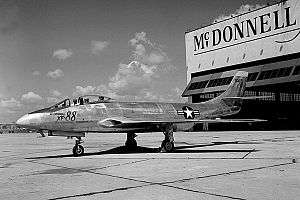
McDonnell XF-88 Voodoo
The McDonnell XF-88 Voodoo was a long-range, twin-engine jet fighter aircraft with swept wings designed for the United States Air Force. Although it never entered service, its design was adapted for the subsequent supersonic F-101 Voodoo.
Design and development
The XF-88 originated from a 1946 United States Army Air Forces requirement for a long-range "penetration fighter" to escort bombers to their targets. It was to be essentially a jet-powered replacement for the wartime North American P-51 Mustang that had escorted Boeing B-17 Flying Fortress bombers over Germany. It was to have a combat radius of 900 mi (1,450 km) and high performance. McDonnell began work on the aircraft, dubbed Model 36, on 1 April 1946. On 20 June the company was given a contract for two prototypes designated XP-88.Dave Lewis was Chief of Aerodynamics on this project.
The initial design was intended to have straight wings and a V-shaped tail but wind tunnel tests indicated aerodynamic problems that led to a conventional tailplane being substituted and the wings being swept. The USAAF confirmed the order for the two prototypes on 14 February 1947, while a change in designation schemes lead to the unflown prototypes being re-designated XF-88 on 1 July 1948, with the type gaining the nickname "Voodoo".
Podcasts:

